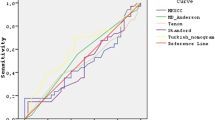Abstract
Background: It is unclear which breast cancer patients with positive sentinel lymph nodes (SLNs) require a completion axillary lymph node dissection. Our aim was to determine factors that predict involvement of nonsentinel axillary nodes (NSLNs) in patients with positive SLNs.
Methods: We reviewed the records of all patients with invasive breast cancer who underwent SLN biopsy at our institution between 1993 and August 2001. Multivariate analysis was used to identify clinicopathologic features in SLN-positive patients that predict involvement of NSLNs.
Results: A total of 131 patients had a positive SLN and underwent completion axillary lymph node dissection. Multivariate analysis revealed that primary tumor >2 cm (P = .009), SLN metastasis >2 mm (P = .024), and lymphovascular invasion (P = .028) were independent predictors of positive NSLNs. The number of SLNs harvested was a significant negative predictor (P = .04). In our model, based on the presence of these factors, the positive predictive value was 100% for a score of 4.
Conclusions: The likelihood of positive NSLNs correlates with primary tumor size, size of the largest SLN metastasis, and presence of lymphovascular invasion. A scoring system incorporating these factors may help determine which patients would benefit from additional axillary surgery.
Similar content being viewed by others
REFERENCES
Albertini JJ, Lyman G, Cox C, et al. Lymphatic mapping and sentinel node biopsy in the patient with breast cancer. JAMA 1996; 276: 1818–22.
Giuliano AE, Jones RC, Brennan M, Statman R. Sentinel lymphadenectomy in breast cancer. J Clin Oncol 1997; 15: 2345–50.
Carter CL, Allen C, Henson DC. Relation of tumor size, lymph node status and survival in 24,740 breast cancer cases. Cancer 1989; 63: 181–7.
Grube BJ, Giuliano AE. Observation of the breast cancer patient with a tumor-positive sentinel node: implications of the ACOSOG Z0011 trial. Semin Surg Oncol 2001; 20: 230–7.
Kakuda JT, Stuntz M, Trivedi V, Klein S, Vargas H. Objective assessment of axillary morbidity in breast cancer treatment. Am Surg 1999; 65: 995–8.
Early Breast Cancer Trialists’ Collaborative Group. Effects of radiotherapy and surgery in early breast cancer. N Engl J Med 1995; 333: 1444–55.
Fisher B, Redmond C, Fisher ER, et al. Ten-year results of a randomized clinical trial comparing radical mastectomy and total mastectomy with or without radiation. N Engl J Med 1985; 312: 674–81.
NIH Consensus Development Conference statement: adjuvant therapy for breast cancer, Nov. 1–3, 2000. J Natl Cancer Inst Monogr 2001;30:5–15.
Braun S, Pantel K, Muller P, et al. Cytokeratin-positive cells in the bone marrow and survival of patients with stage I, II, or III breast cancer. N Engl J Med 2000; 342: 525–33.
Diel I, Kaufman M, Costa SD, et al. Micrometastatic breast cancer cells in bone marrow at primary surgery: prognostic value in comparison with nodal status. J Natl Cancer Inst 1996; 88: 1652–8.
Hayward JL. The Guys’ Hospital trials of breast conservation. In: Harris JR, Hellman S, Silen W, eds. Conservative Management of Breast Cancer. Philadelphia: Lippincott, 1983: 77–90.
Breslin TM, Cohen L, Sahin A, et al. Sentinel lymph node biopsy is accurate after neoadjuvant chemotherapy for breast cancer. J Clin Oncol 2000; 18: 3480–6.
Yared MA, Middleton LP, Smith TL, et al. Recommendations for sentinel lymph node processing in breast cancer. Am J Surg Pathol 2002; 26: 377–82.
Giuliano AE, Kirgan DM, Guenther M, Morton D. Lymphatic mapping and sentinel lymphadenectomy for breast cancer. Ann Surg 1994; 220: 391–401.
Barnwell JM, Arredondo MA, Kollmorgen D. Sentinel node biopsy in breast cancer. Ann Surg Oncol 1998; 1998: 126–30.
Veronesi U, Paganelli G, Galimberti V. Sentinel-node biopsy to avoid axillary dissection in breast cancer with clinically negative lymph-nodes. Lancet 1997; 349: 1864–7.
Turner RR, Chu KU, Qi K, et al. Pathologic features associated with nonsentinel lymph node metastases in patients with metastatic breast carcinoma in a sentinel lymph node. Cancer 2000; 89: 574–81.
Abdessalam SF, Zervos EE, Prasad M, et al. Predictors of positive axillary lymph nodes after sentinel lymph node biopsy in breast cancer. Am J Surg 2001; 182: 316–20.
Chu KU, Turner RR, Hansen NM, Brennan MB, Bilchik A, Giuliano AE. Do all patients with sentinel node metastasis from breast carcinoma need complete axillary node dissection? Ann Surg 1999; 229: 536–41.
Kamath BJ, Giuliano R, Dauway EL, et al. Characteristics of the sentinel lymph node in breast cancer predict further involvement of higher-echelon nodes in the axilla. Arch Surg 2001; 136: 688–92.
Reynolds C, Mick R, Donohue JH, et al. Sentinel lymph node biopsy with metastasis: can axillary dissection be avoided in some patients with breast cancer? J Clin Oncol 1999; 17: 1720–6.
Wong SL, Edwards MJ, Chao C, et al. Predicting the status of the nonsentinel axillary nodes. Arch Surg 2001; 136: 563–8.
Weiser MR, Montgomery LL, Tan LK, et al. Lymphovascular invasion enhances the prediction of non-sentinel node metastases in breast cancer patients with positive sentinel nodes. Ann Surg Oncol 2001; 8: 145–9.
McGuckin MA, Cummings MC, Walsh MD, Hohn BG, Bennet IC, Wright RG. Occult axillary node metastases in breast cancer: their detection and prognostic significance. Br J Cancer 1996; 73: 88–95.
de Mascarel I, Bonichon F, Coindre JM, Trojani M. Prognostic significance of breast cancer axillary lymph node micrometastases assessed by two special techniques: reevaluation with longer follow-up. Br J Cancer 1992; 66: 523–7.
Cote RJ, Peterson HF, Chaiwun B, et al. Role of immunohistochemical detection of lymph-node metastases in management of breast cancer. Lancet 1999; 354: 896–900.
Author information
Authors and Affiliations
Corresponding author
Rights and permissions
About this article
Cite this article
Hwang, R.F., Krishnamurthy, S., Hunt, K.K. et al. Clinicopathologic Factors Predicting Involvement of Nonsentinel Axillary Nodes in Women With Breast Cancer. Ann Surg Oncol 10, 248–254 (2003). https://doi.org/10.1245/ASO.2003.05.020
Received:
Accepted:
Issue Date:
DOI: https://doi.org/10.1245/ASO.2003.05.020




